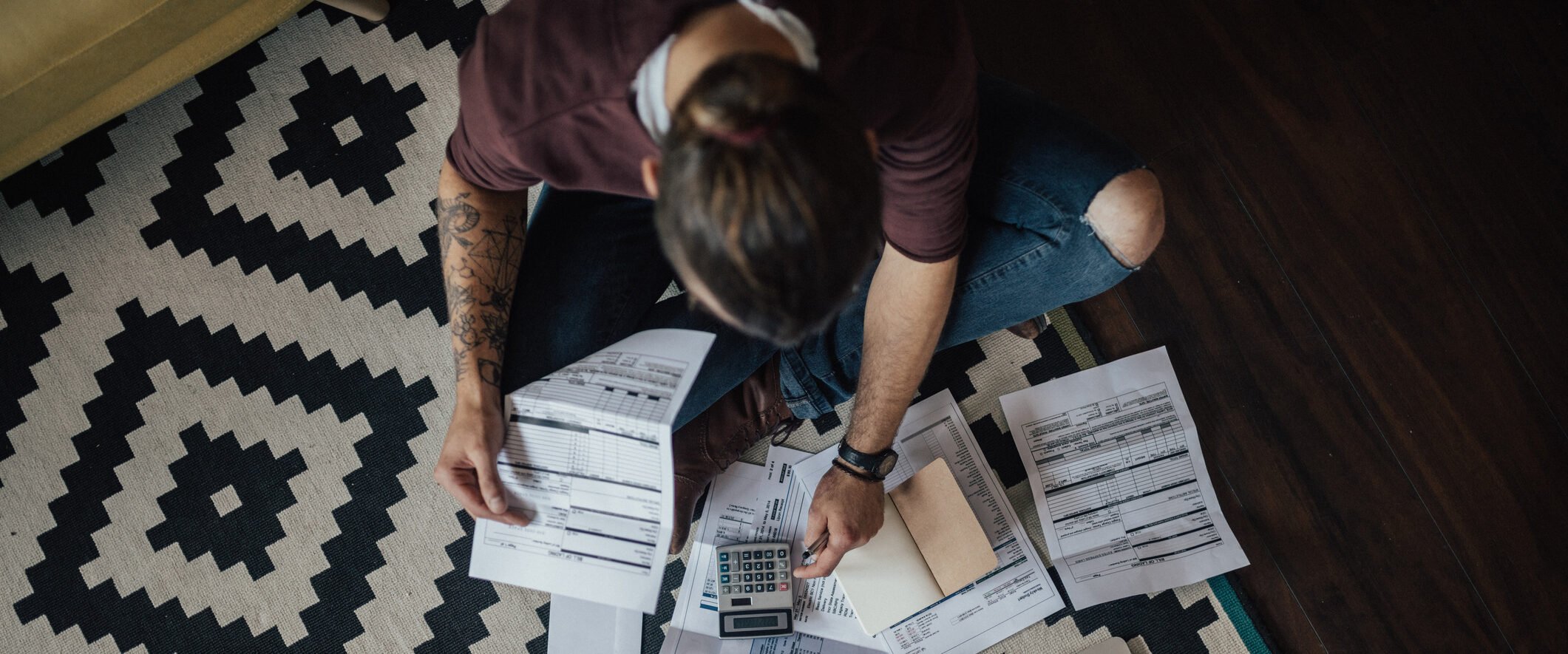Canadian debt levels have been on the rise for years. According to Statistics Canada, the ratio of household debt to disposable income was 173.08% in the second quarter of 2021. That means for every dollar Canadians earned, they owed $1.73.
To make things worse, many Canadians are still dealing with the financial fallout of COVID-19. Government assistance programs are wrapping up even though many haven’t returned to full-time work. Couple that with the holiday season, a time when people typically spend more than usual, and it’s a recipe for debt disaster.
If you’re feeling the squeeze, know you’re not alone. But without a plan to address it, debt could harm your credit score, relationships and mental health. To get your debt under control, here are some financial resolutions to make in 2022.
» MORE: What debt is and how to handle it
1. Confront your debt
Many people struggle with debt. While it’s likely not something you’re proud of, you needn’t feel ashamed. In fact, just taking the time to read about how to get out of debt shows that you’re ready to get your finances in order.
To deal with debt, the first thing you need to do is confront it — look the entire amount right in the eye and let it know you’re not afraid.
In a spreadsheet or on a piece of paper, list how much you owe, who you owe it to and how much interest you’re paying. To keep things organized, you could organize it either the amount you owe or the interest rate. It might look something like this:
| Type of debt | Current balance | Interest rate |
|---|---|---|
| Payday loan | $675 | 45% |
| Credit card | $3,687 | 19.99% |
| Auto loan | $15,000 | 8% |
| Bank line of credit | $4,000 | 6% |
| Student loans | $25,500 | 3% |
| TOTAL | $48,862 |
This visual reference will help you plan which debts to tackle first and, as you update it over time, make it easier to track your progress.
2. Make a budget
If you don’t have a detailed budget already, now is the time to make one. Creating a budget can happen in just a few simple steps.
First, write down your net income, which is the amount of money you bring home every month after taxes and costs like Employment Insurance and Canada Pension Plan contributions are deducted.
Next, write down your fixed expenses — things that cost the same amount every month — such as your rent, utilities and cell phone/internet services.
Then, record the minimum required payment for each of your debts, including credit cards or student loans.
Next, list out your variable expenses — things that might cost a different amount each month — like groceries, entertainment and gas.
Finally, subtract your total expenses from your net income to see which is higher.
Are you spending more than you take in? If so, you may have to make some lifestyle changes in order to deal with your debt. Is your income higher than your expenses? If so, you’re in a great position to allocate extra money toward debt payments.
» MORE: How to budget your money
3. Choose a debt repayment strategy
Armed with a good sense of how much debt you’re carrying and a reasonable budget, it’s time to plan your attack.
Your first goal should be to avoid collections by making on-time minimum payments on all debts. But due to the interest rate charged by creditors, just making minimum payments won’t actually reduce your overall debt.
If you want to shrink your balances and eventually become debt free, you’ll need to pay more than the minimum. But with only so much income to work with, which debts should you focus on first?
There are two debt repayment strategies that can help you decide: the debt avalanche method and the debt snowball method.
Debt avalanche
With the debt avalanche method, the debt with the highest interest rate is your top priority. Make the minimum payment on all your other debts, and then use any funds this frees up to pay extra to the creditors that are charging you the most interest.
It’s simple math when you think about it. Credit card debt that charges 19.99% interest is costing you more in the long run than student debt with a 3% interest rate. The debt avalanche strategy requires patience, but it pays off by eliminating your most expensive debt first.
» MORE: How credit card interest rates work in Canada
Debt snowball
With the debt snowball method, interest rates don’t matter — you focus on the debt with the lowest balance first. Make the minimum payment on all your other debts, and then use any extra funds this frees up to pay more toward your smallest debt.
While this won’t result in the same savings as the avalanche method, completely paying off a debt is an accomplishment that may give you a welcome psychological boost. And once that debt is eliminated, you can take the entire amount you were paying toward it (monthly minimum plus any extra funds) and target the next-smallest debt — just like a snowball rolling down a hill and getting bigger along the way.
» MORE: Understanding your debt-to-income ratio
4. Freeze your spending for 30 days
It doesn’t matter how much debt you have, challenging yourself to a “no-spend” month can help you regain some control over your finances.
The concept is simple, you eliminate all non-essential spending for 30 days. Think: getting food delivered, buying clothes online or renting digital movies. What you consider essential may differ from others, but the idea is to minimize your spending to free-up some cash for debt repayment.
If a month seems impossible, try for a week first and then increase that timeframe next month.
» MORE: Price-matching tips to help you save money
5. Transfer your debt to a low-interest credit card
Some credit cards allow you to transfer existing debt from another card. This can be beneficial since balance transfer options often come with favourable terms. For example, your interest rate might be 0% for 12 months on the transferred amount.
If you focus on making extra payments during this promotional period, you could get pretty far ahead because your entire payment would be applied to the balance. Plus, if you transfer your balance from a high-interest card to a low-interest credit card, you’ll still be paying less in interest when the promotional period ends.
» MORE: What is a balance transfer credit card?
6. Consolidate your debt
If you have a good credit score, you may qualify for a line of credit from your financial institution. This is important because bank loans often have a lower interest rate than credit cards or personal loans.
Assuming you’re approved for a line of credit that’s sufficient, you could take that loan and immediately pay off all your other debts. You’d now only have one monthly payment to worry about, and thanks to a lower interest rate, you may be able to shrink the balance more quickly.
» MORE: Is debt consolidation right for you?
7. Focus on your credit
Paying down your overall debt can have a positive impact on your credit score, as it reduces your credit utilization ratio. And a better credit score will make it easier to get approved for balance-transfer credit cards or debt consolidation loans. Use strategies like the debt snowball or avalanche to chip away at your balances, and you may see a stronger score as a result.
Another way to improve your credit score is to get a secured credit card. These cards require a cash deposit and you can only spend the funds you’ve deposited. But every on-time payment will help rebuild your credit score over time.
» MORE: How to check your credit score and rebuild credit history
8. Seek professional help
If you’re overwhelmed by your debt or unsure about what to do next, consider getting help from a professional. One option is to speak to a licensed insolvency trustee, as they can advise you if a consumer proposal or declaring bankruptcy is a viable solution.
Alternatively, there are non-profit debt counsellors or debt coaches that may be able to give you advice about budgeting and debt consolidation options.
The point is, you’re not alone. If your debt is keeping you up at night, resolve to take action in 2022 — even if it’s just reaching out and talking to someone who can help you get things under control.
DIVE EVEN DEEPER

How to Get a Free Credit Report in Canada
Your credit report is a record of your credit history that’s used to calculate your credit score. Get your free credit report by contacting a credit bureau.

7 Money Strategies for Savvy Holiday Shopping
When shopping for holiday gifts this year, create your own discounts, use credit card rewards and consider alternative payment options.

Understanding the Main Types of Debt
Debt can be divided into several types: secured and unsecured, good and bad. Other types of debt include credit card debt, student loans, medical bills and mortgages.

18 Ways to Make Money Online and Offline in Canada
There are numerous ways to make money online and off — like freelancing, selling unused stuff, housesitting and more.

